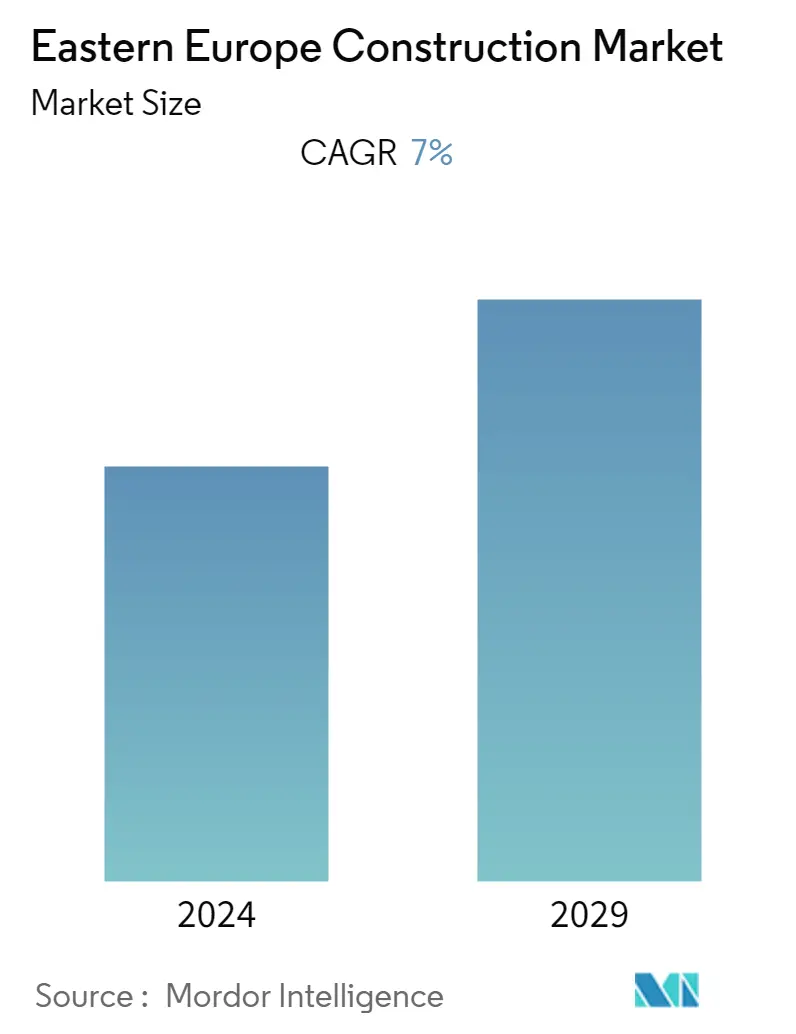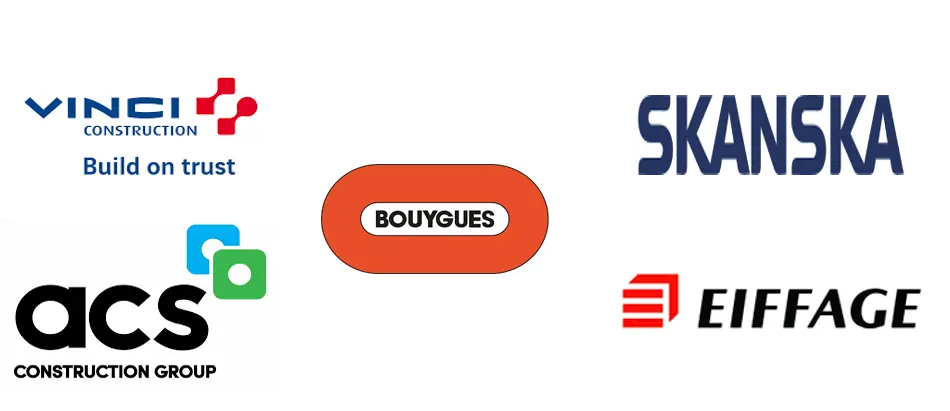Market Size of Eastern Europe Construction Industry

| Study Period | 2020 - 2029 |
| Base Year For Estimation | 2023 |
| Forecast Data Period | 2024 - 2029 |
| Historical Data Period | 2020 - 2022 |
| CAGR | 7.00 % |
| Market Concentration | Medium |
Major Players
*Disclaimer: Major Players sorted in no particular order |
Eastern Europe Construction Market Analysis
The Eastern Europe Construction Market is estimated to grow at a CAGR of approximately 7% during the forecast period.
The European construction market is expected to continue with an average annual growth of more than 3% relative to the weakest building sector (+ 1%). At the country level, the positive development in Eastern European countries will be supported by strong growth of around +6%.
Prime real estate investors are looking to new prospects for the developing markets in Eastern Europe. Cities like Budapest, Prague, and Warsaw show strong signs of growth and attract buyers who are comfortable with some risk, especially in Hungary's prime markets, where the political climate has introduced a degree of uncertainty.
A common trend among these rising Eastern European markets is that demand comes mainly from domestic consumers, suggesting an increasing number of international consumers are involved in this year's investment. Such global markets are home to a growing number of high-end inventories, and many Eastern European cities will see the luxurious new technologies launch in 2020. In recent years, many luxury high-rises have gone up in Warsaw. Prime real estate investors are awaiting the completion of Foksal 13/15, a property from the 19th century that was the residence of many prominent Poles and has been renovated to house luxury apartments.
Eastern Europe Construction Industry Segmentation
The Eastern Europe construction market covers the growing construction projects in different sectors, like commercial construction, residential construction, industrial construction, infrastructure (transportation construction), and energy and utility construction and by Geography Romania, Hungary, Croatia, Ukraine, Bulgaria and Rest of Eastern Europe. Along with the scope of the report also it analyses the key players and the competitive landscape in the Eastern Europe Construction Market.
| By Sector | |
| Residential | |
| Commercial | |
| Industrial | |
| Infrastruture (Transportation) | |
| Energy and Utilities |
| BY Geography | |
| Romania | |
| Hungary | |
| Croatia | |
| Ukraine | |
| Bulgaria | |
| Rest of Eastern Europe |
Eastern Europe Construction Market Size Summary
The Eastern Europe construction market is poised for significant growth, driven by a robust demand from both domestic and international consumers. Cities such as Budapest, Prague, and Warsaw are emerging as key hubs for real estate investment, attracting buyers willing to navigate the inherent risks associated with these developing markets. The region's construction sector is characterized by a surge in luxury high-rise developments, particularly in Warsaw, where historical properties are being transformed into upscale residential units. This trend is supported by the introduction of advanced technologies and the increasing presence of high-end inventories, which are appealing to prime real estate investors seeking long-term capital appreciation and diversification benefits.
The market's expansion is further bolstered by a rise in construction permits and a positive economic outlook, with significant contributions from the construction and real estate sectors to the region's economic growth. The market remains fragmented, with major players like Vinci, ACS, Bouygues, Eiffage, and Skanska actively participating in the region's development. The construction output has seen substantial year-on-year growth, particularly in building construction, indicating a strong recovery and a promising future for the Eastern European construction industry. This growth trajectory is expected to continue, supported by ongoing investments and the region's strategic importance in the broader European market.
Eastern Europe Construction Market Size - Table of Contents
-
1. MARKET DYNAMICS
-
1.1 Market Overview
-
1.2 Market Drivers
-
1.3 Market Restraints
-
1.4 Value Chain / Supply Chain Analysis
-
1.5 Porters 5 Force Analysis
-
1.5.1 Threat of New Entrants
-
1.5.2 Bargaining Power of Buyers/Consumers
-
1.5.3 Bargaining Power of Suppliers
-
1.5.4 Threat of Substitute Products
-
1.5.5 Intensity of Competitive Rivalry
-
-
1.6 Market Insights
-
1.6.1 Current Economic and Construction Market Scenario
-
1.6.2 Technological Innovations in the Construction Sector
-
1.6.3 Impact of Government Regulations and Initiatives on the Industry
-
1.6.4 Impact of COVID - 19 on the market
-
-
-
2. MARKET SEGMENTATION
-
2.1 By Sector
-
2.1.1 Residential
-
2.1.2 Commercial
-
2.1.3 Industrial
-
2.1.4 Infrastruture (Transportation)
-
2.1.5 Energy and Utilities
-
-
2.2 BY Geography
-
2.2.1 Romania
-
2.2.2 Hungary
-
2.2.3 Croatia
-
2.2.4 Ukraine
-
2.2.5 Bulgaria
-
2.2.6 Rest of Eastern Europe
-
-
Eastern Europe Construction Market Size FAQs
What is the current Eastern Europe Construction Market size?
The Eastern Europe Construction Market is projected to register a CAGR of 7% during the forecast period (2024-2029)
Who are the key players in Eastern Europe Construction Market?
Vinci , ACS , Bouygues , Eiffage and Skanska are the major companies operating in the Eastern Europe Construction Market.

